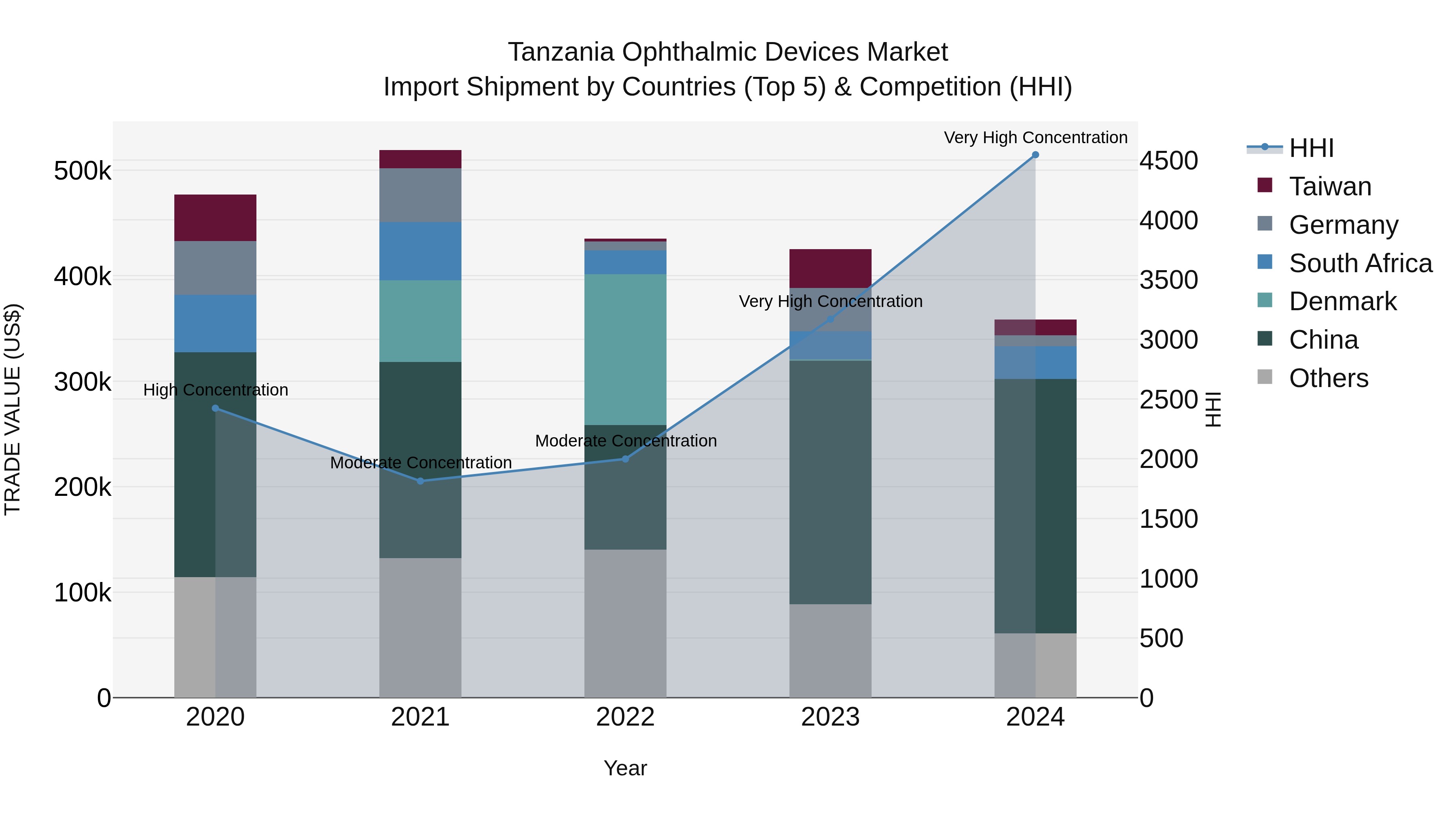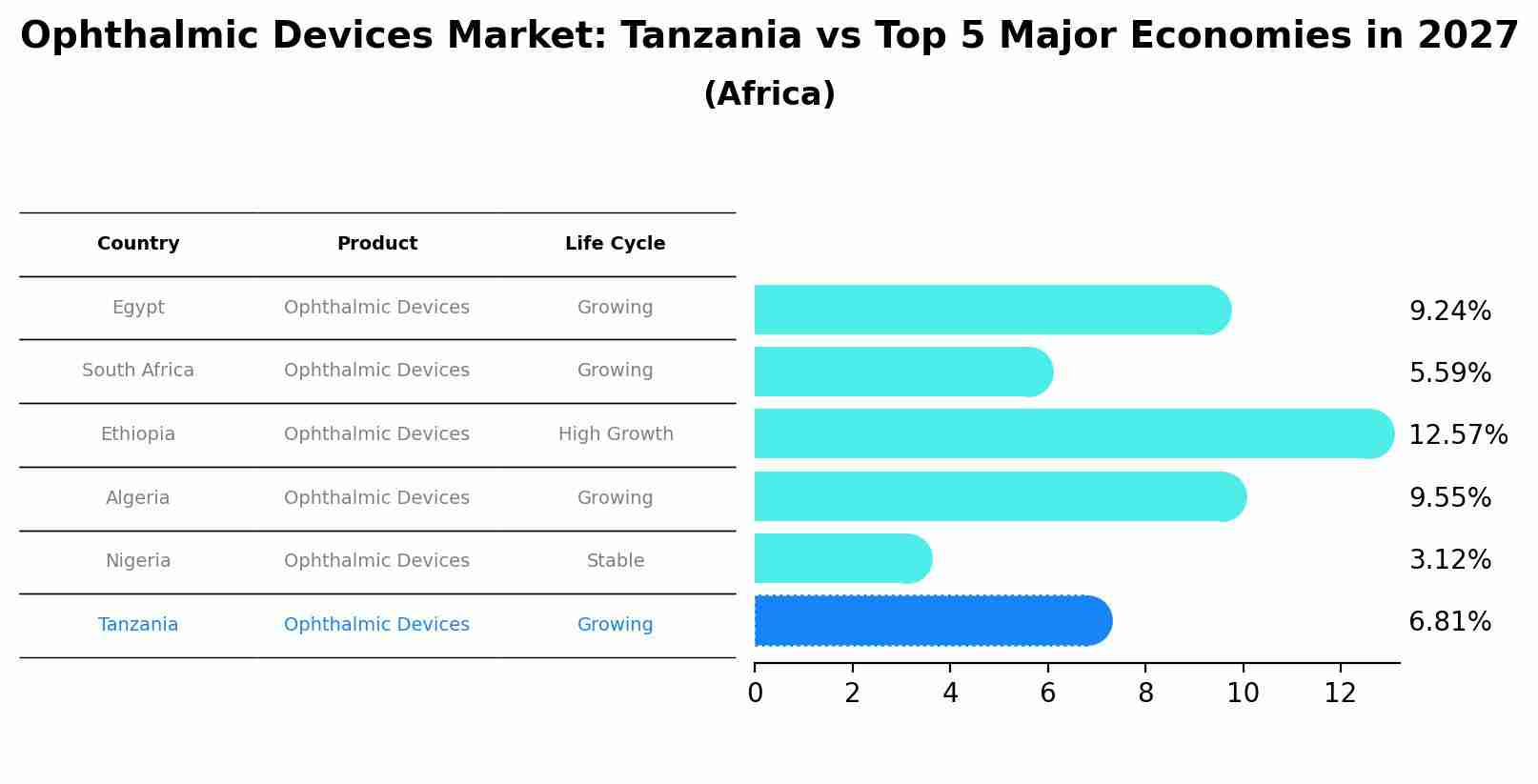Tanzania Ophthalmic Devices Market (2025-2031) Outlook | Analysis, Growth, Value, Industry, Forecast, Size, Share, Revenue, Companies & Trends
| Product Code: ETC367915 | Publication Date: Aug 2022 | Updated Date: Nov 2025 | Product Type: Market Research Report | |
| Publisher: 6Wresearch | Author: Sachin Kumar Rai | No. of Pages: 75 | No. of Figures: 35 | No. of Tables: 20 |
Tanzania Ophthalmic Devices Market: Top 5 Importing Countries and Market Competition (HHI) Analysis
Despite a high concentration of imports from top countries like China and South Africa, the ophthalmic devices market in Tanzania experienced a negative CAGR of -6.89% from 2020 to 2024. Furthermore, the growth rate declined significantly by -15.73% in 2024 compared to the previous year. This trend suggests a challenging market environment for ophthalmic device imports in Tanzania, indicating potential shifts in market dynamics and demand for these products in the country.

Ophthalmic Devices Market: Tanzania vs Top 5 Major Economies in 2027 (Africa)
In the Africa region, the Ophthalmic Devices market in Tanzania is projected to expand at a growing growth rate of 6.81% by 2027. The largest economy is Egypt, followed by South Africa, Ethiopia, Algeria and Nigeria.

Tanzania Ophthalmic Devices Market Synopsis
The Tanzania Ophthalmic Devices Market is experiencing steady growth driven by factors such as an increasing prevalence of eye diseases, a growing elderly population, and improving healthcare infrastructure. Key product segments in the market include diagnostic devices, surgical devices, and vision care products. The demand for ophthalmic devices is also being propelled by rising awareness about eye health and the availability of advanced technologies. However, challenges such as limited access to eye care services in remote areas and a lack of skilled ophthalmic professionals may hinder market growth. Overall, the market presents opportunities for companies to expand their presence in Tanzania by offering innovative and cost-effective ophthalmic devices tailored to the needs of the local population.
Tanzania Ophthalmic Devices Market Trends
The Tanzania Ophthalmic Devices Market is currently experiencing a growing demand for advanced diagnostic and surgical equipment due to an increasing prevalence of eye diseases and a growing aging population. There is a noticeable shift towards digital and innovative technologies in devices such as optical coherence tomography (OCT) scanners, femtosecond lasers for cataract surgery, and advanced phacoemulsification systems. Additionally, there is a rising adoption of telemedicine and remote monitoring solutions for eye care services, especially in rural areas where access to ophthalmologists is limited. Market players are focusing on developing cost-effective and portable devices to cater to the needs of underserved regions in Tanzania. Overall, there is a trend towards enhancing efficiency, accuracy, and accessibility in ophthalmic care through technological advancements in the Tanzania market.
Tanzania Ophthalmic Devices Market Challenges
In the Tanzania Ophthalmic Devices Market, some key challenges include limited access to advanced technology and equipment, inadequate healthcare infrastructure and facilities, shortage of skilled ophthalmologists and technicians, as well as disparities in healthcare services between urban and rural areas. Additionally, affordability and cost constraints among the population hinder the adoption of high-end ophthalmic devices, leading to a preference for lower-cost alternatives. Regulatory hurdles and import restrictions also pose challenges for market entry and product distribution. Overall, addressing these challenges requires targeted investments in healthcare infrastructure, training programs for healthcare professionals, strategic partnerships with international manufacturers, and initiatives to improve affordability and accessibility of ophthalmic devices in Tanzania.
Tanzania Ophthalmic Devices Market Investment Opportunities
The Tanzania Ophthalmic Devices Market presents promising investment opportunities due to the increasing prevalence of eye disorders and the growing awareness about eye health in the country. Key areas for investment include advanced diagnostic equipment such as retinal imaging devices and optical coherence tomography machines, as well as surgical instruments like phacoemulsification systems for cataract surgery. Additionally, there is a rising demand for contact lenses, intraocular lenses, and other vision correction products among the population. Investing in innovative technologies and products that cater to the specific needs of the Tanzanian market, along with strategic partnerships with local healthcare providers, could lead to substantial growth and returns in the ophthalmic devices sector in Tanzania.
Jordan Agar Market Government Policies
The government of Tanzania has implemented various policies related to the ophthalmic devices market, aimed at improving access to quality eye care services across the country. These policies include the establishment of regulatory frameworks to ensure the safety and efficacy of ophthalmic devices imported and distributed in Tanzania. Additionally, the government has focused on increasing awareness about eye health and promoting preventive measures to reduce the prevalence of eye diseases. Furthermore, initiatives to train and equip healthcare professionals in the field of ophthalmology have been introduced to enhance the capacity of the healthcare system in addressing eye care needs. Overall, these government policies play a crucial role in shaping the ophthalmic devices market in Tanzania and improving eye health outcomes for the population.
Tanzania Ophthalmic Devices Market Future Outlook
The Tanzania Ophthalmic Devices Market is expected to show steady growth in the coming years due to factors such as increasing awareness about eye health, a rising elderly population, and the expansion of healthcare infrastructure. The demand for ophthalmic devices, including diagnostic tools, surgical instruments, and vision correction products, is anticipated to rise as the country`s healthcare sector continues to develop. Technological advancements in the field of ophthalmology and increasing investment in healthcare services are also likely to drive market growth. However, challenges such as limited access to specialized eye care services in rural areas and affordability issues for some segments of the population may hinder market expansion. Overall, the Tanzania Ophthalmic Devices Market presents opportunities for manufacturers and healthcare providers to address the growing needs of the population for quality eye care products and services.
Key Highlights of the Report:
- Tanzania Ophthalmic Devices Market Outlook
- Market Size of Tanzania Ophthalmic Devices Market, 2024
- Forecast of Tanzania Ophthalmic Devices Market, 2031
- Historical Data and Forecast of Tanzania Ophthalmic Devices Revenues & Volume for the Period 2021 - 2031
- Tanzania Ophthalmic Devices Market Trend Evolution
- Tanzania Ophthalmic Devices Market Drivers and Challenges
- Tanzania Ophthalmic Devices Price Trends
- Tanzania Ophthalmic Devices Porter's Five Forces
- Tanzania Ophthalmic Devices Industry Life Cycle
- Historical Data and Forecast of Tanzania Ophthalmic Devices Market Revenues & Volume By Product for the Period 2021 - 2031
- Historical Data and Forecast of Tanzania Ophthalmic Devices Market Revenues & Volume By Optical Coherence Tomography Scanners for the Period 2021 - 2031
- Historical Data and Forecast of Tanzania Ophthalmic Devices Market Revenues & Volume By Fundus Cameras for the Period 2021 - 2031
- Historical Data and Forecast of Tanzania Ophthalmic Devices Market Revenues & Volume By Perimeters/Visual Field Analyzers for the Period 2021 - 2031
- Historical Data and Forecast of Tanzania Ophthalmic Devices Market Revenues & Volume By Autorefractors and Keratometers for the Period 2021 - 2031
- Historical Data and Forecast of Tanzania Ophthalmic Devices Market Revenues & Volume By Ophthalmic Ultrasound Imaging Systems for the Period 2021 - 2031
- Historical Data and Forecast of Tanzania Ophthalmic Devices Market Revenues & Volume By Ophthalmic Pachymeters for the Period 2021 - 2031
- Historical Data and Forecast of Tanzania Ophthalmic Devices Market Revenues & Volume By Tonometers for the Period 2021 - 2031
- Historical Data and Forecast of Tanzania Optical Coherence Tomography Scanners Ophthalmic Devices Market Revenues & Volume By Slit Lamps for the Period 2021 - 2031
- Historical Data and Forecast of Tanzania Ophthalmic Devices Market Revenues & Volume By Application for the Period 2021 - 2031
- Historical Data and Forecast of Tanzania Ophthalmic Devices Market Revenues & Volume By Cataract for the Period 2021 - 2031
- Historical Data and Forecast of Tanzania Ophthalmic Devices Market Revenues & Volume By Vitreo retinal disorders for the Period 2021 - 2031
- Historical Data and Forecast of Tanzania Ophthalmic Devices Market Revenues & Volume By Glaucoma for the Period 2021 - 2031
- Historical Data and Forecast of Tanzania Ophthalmic Devices Market Revenues & Volume By Refractor Disorders for the Period 2021 - 2031
- Historical Data and Forecast of Tanzania Ophthalmic Devices Market Revenues & Volume By End-use for the Period 2021 - 2031
- Historical Data and Forecast of Tanzania Ophthalmic Devices Market Revenues & Volume By Hospitals and Eye Clinics for the Period 2021 - 2031
- Historical Data and Forecast of Tanzania Ophthalmic Devices Market Revenues & Volume By Academic and Research Laboratory for the Period 2021 - 2031
- Historical Data and Forecast of Tanzania Ophthalmic Devices Market Revenues & Volume By Others for the Period 2021 - 2031
- Tanzania Ophthalmic Devices Import Export Trade Statistics
- Market Opportunity Assessment By Product
- Market Opportunity Assessment By Application
- Market Opportunity Assessment By End-use
- Tanzania Ophthalmic Devices Top Companies Market Share
- Tanzania Ophthalmic Devices Competitive Benchmarking By Technical and Operational Parameters
- Tanzania Ophthalmic Devices Company Profiles
- Tanzania Ophthalmic Devices Key Strategic Recommendations
Frequently Asked Questions About the Market Study (FAQs):
- Single User License$ 1,995
- Department License$ 2,400
- Site License$ 3,120
- Global License$ 3,795
Search
Thought Leadership and Analyst Meet
Our Clients
Related Reports
- Canada Oil and Gas Market (2026-2032) | Share, Segmentation, Value, Industry, Trends, Forecast, Analysis, Size & Revenue, Growth, Competitive Landscape, Outlook, Companies
- Germany Breakfast Food Market (2026-2032) | Industry, Share, Growth, Size, Companies, Value, Analysis, Revenue, Trends, Forecast & Outlook
- Australia Briquette Market (2025-2031) | Growth, Size, Revenue, Forecast, Analysis, Trends, Value, Share, Industry & Companies
- Vietnam System Integrator Market (2025-2031) | Size, Companies, Analysis, Industry, Value, Forecast, Growth, Trends, Revenue & Share
- ASEAN and Thailand Brain Health Supplements Market (2025-2031) | Strategy, Consumer Insights, Analysis, Investment Trends, Opportunities, Growth, Size, Share, Industry, Revenue, Segments, Value, Segmentation, Supply, Forecast, Restraints, Outlook, Competition, Drivers, Trends, Demand, Pricing Analysis, Competitive, Strategic Insights, Companies, Challenges
- ASEAN Bearings Market (2025-2031) | Strategy, Consumer Insights, Analysis, Investment Trends, Opportunities, Growth, Size, Share, Industry, Revenue, Segments, Value, Segmentation, Supply, Forecast, Restraints, Outlook, Competition, Drivers, Trends, Demand, Pricing Analysis, Competitive, Strategic Insights, Companies, Challenges
- Europe Flooring Market (2025-2031) | Outlook, Share, Industry, Trends, Forecast, Companies, Revenue, Size, Analysis, Growth & Value
- Saudi Arabia Manlift Market (2025-2031) | Outlook, Size, Growth, Trends, Companies, Industry, Revenue, Value, Share, Forecast & Analysis
- Uganda Excavator, Crane, and Wheel Loaders Market (2025-2031) | Strategy, Consumer Insights, Analysis, Investment Trends, Opportunities, Growth, Size, Share, Industry, Revenue, Segments, Value, Segmentation, Supply, Forecast, Restraints, Outlook, Competition, Drivers, Trends, Demand, Pricing Analysis, Competitive, Strategic Insights, Companies, Challenges
- Rwanda Excavator, Crane, and Wheel Loaders Market (2025-2031) | Strategy, Consumer Insights, Analysis, Investment Trends, Opportunities, Growth, Size, Share, Industry, Revenue, Segments, Value, Segmentation, Supply, Forecast, Restraints, Outlook, Competition, Drivers, Trends, Demand, Pricing Analysis, Competitive, Strategic Insights, Companies, Challenges
Industry Events and Analyst Meet
Whitepaper
- Middle East & Africa Commercial Security Market Click here to view more.
- Middle East & Africa Fire Safety Systems & Equipment Market Click here to view more.
- GCC Drone Market Click here to view more.
- Middle East Lighting Fixture Market Click here to view more.
- GCC Physical & Perimeter Security Market Click here to view more.
6WResearch In News
- Doha a strategic location for EV manufacturing hub: IPA Qatar
- Demand for luxury TVs surging in the GCC, says Samsung
- Empowering Growth: The Thriving Journey of Bangladesh’s Cable Industry
- Demand for luxury TVs surging in the GCC, says Samsung
- Video call with a traditional healer? Once unthinkable, it’s now common in South Africa
- Intelligent Buildings To Smooth GCC’s Path To Net Zero


















